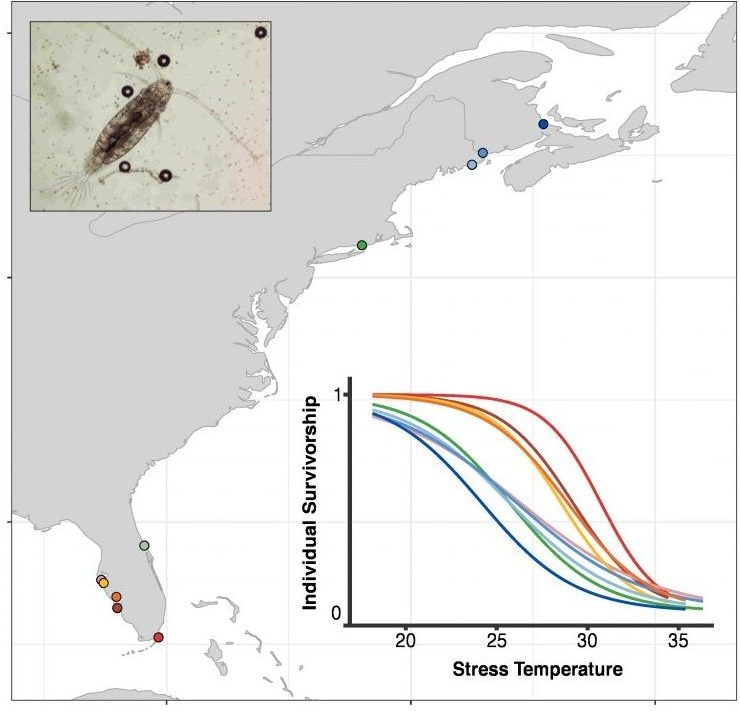Oct 1 2019
The process of natural selection is common knowledge, through which organisms adjust to their environments. But what occurs when there are no barricades to gene flow and organisms are floating freely between highly variable environmental surroundings?
 Sample range of copepods studied. (Image credit: Matthew Sasaki/Submitted Illustration)
Sample range of copepods studied. (Image credit: Matthew Sasaki/Submitted Illustration)
University of Connecticut (UConn) scientists conducted a new study that aims to tease out some of the numerous pressures that stimulate adaptation in small, extensively dispersed marine animals known as copepods—small crustaceans found in almost every saltwater and freshwater habitat—to comprehend how these animals may deal with a gradually warming climate.
We often assume that species adapt in fairly predictable patterns. However, what we know about these patterns is mainly from animals living on land rather than animals living in ocean currents.
Matthew Sasaki, Doctoral Student, Department of Marine Sciences, University of Connecticut
Sasaki is based in the lab of Professor Hans Dam.
Established on the general knowledge about organisms on land, the expectation is that populations of copepods in warmer environments such as Florida would be more resilient to elevated temperatures while populations in colder environments like Canada would have lower thermal tolerance.
To check if this theory held true in the marine setting, the researchers took copepods from sites spanning more than 20° latitude, from Northern New Brunswick, Canada to the Florida Keys.
Sasaki tested genetic information from the organisms as they were gathered to examine how connected the populations were. He also took live copepods back to the lab to be raised under regulated conditions to examine thermal tolerance.
The findings did not reveal any considerable local genetic adaptation.
Despite the fact the sample locations are thousands of miles apart, and you would expect local adaptations, that is not what we saw for most cases.
Hans Dam, Professor and Laboratory Head, Department of Marine Sciences, University of Connecticut
Across the majority of the sampled range, there were no real variances in thermal tolerance between populations even when populations were separated by over 1000 km.
But, another way organisms can deal with environmental variation is phenotypic plasticity, which is the capability of organisms to react without genetic alteration. The scientists demonstrated that plasticity is very important in copepods.
Certain populations in colder waters had higher plasticity—an improved ability to react to environmental variation—than particular populations in the warmest waters.
The scientists wrote that this plasticity may decrease susceptibility to extreme temperature variations, such as those observed with heatwaves, but only to a point. As total ocean temperatures rise, the probability for extreme weather events such as heatwaves also increases, which may force marine ecosystems to their limits.
Luckily, this study proposes that the extensive distribution of thermal plasticity and gene flow means thermal adaptation can occur comparatively quickly, decreasing organisms’ susceptibility to warming.
Small Yet Mighty
Though small in size, copepods are the most abundant species in the ocean and possibly on the planet, said Dam, and they play a crucial role in the marine food web and the cycling of nutrients within the ecosystem.
Copepods feed on phytoplankton, which are very small, single-celled organisms at the bottom of the food web. In order for the energy held in phytoplankton to be moved up the food chain to larger animals like whales or fish, it has to pass via copepods.
Over and above the role played by copepods in the food web, they are also a crucial component of the ocean’s carbon cycle, stated Sasaki. With torpedo-shaped fecal pellets, the carbon contained in their droppings is able to sink to considerable depths within the marine environment where it stays sequestered and out of the atmosphere for extended periods of time.
Given the critical role of copepods in the general health of the ocean, substantial variations in population size will have consequences.
By virtue of their sheer numbers they are bound to have large effects on carbon transfer from the upper levels of the ocean as well as from removing carbon from the surface waters and transporting to the deep ocean.
Hans Dam, Professor and Laboratory Head, Department of Marine Sciences, University of Connecticut
However, climate changes may also be advantageous in certain cases.
“It all depends on where a particular population is located and if or how well they are locally adapted. In terrestrial environments, there are geographic boundaries between populations whereas in the ocean there is a constant mixing and exchange. The beauty of this paper is that it shows evidence of how that exchange constrains the ability of populations to adapt locally,” concluded Dam.